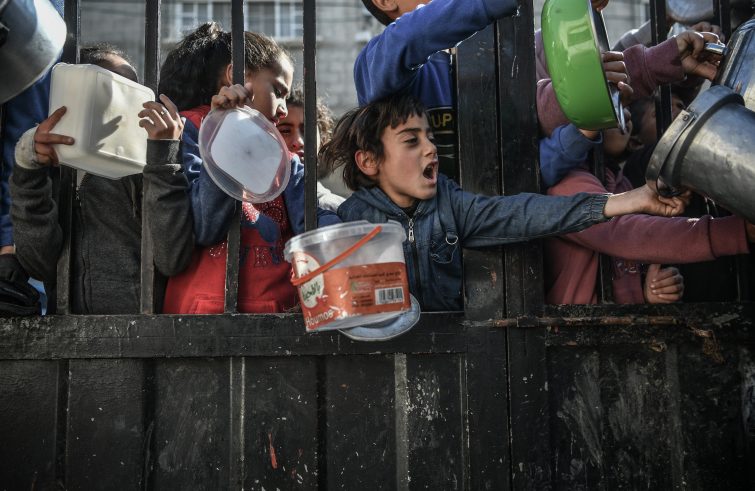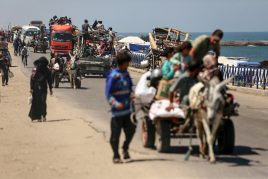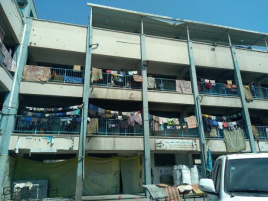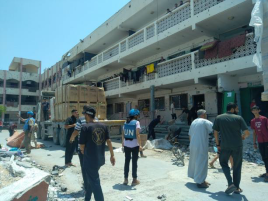
Intense fighting continues in the Gaza Strip, with nearly 39,000 Palestinians dead and over 89,000 wounded, according to the Hamas-controlled Gaza Health Ministry. On the Israeli side, military sources (IDF) report more than 1,526 Israelis and foreign nationals killed, most of them on 7 October and in the immediate aftermath. Of these, 326 were killed in Gaza or along the Israeli border since the beginning of the ground operation. Over 2,100 soldiers have been wounded. Hamas is still holding one hundred and twenty Israeli hostages. The humanitarian situation has become increasingly desperate: international organisations such as the WHO and the UN estimate that 1.9 million Gazans have been internally displaced (about 90% of the total population), sheltering in makeshift shelters, tents, schools and UNRWA facilities. Andrea De Domenico, Director of the UN Office for the Coordination of Humanitarian Affairs in the Occupied Palestinian Territories (OCHA), briefed SIR on the latest developments regarding the humanitarian emergency in Gaza.
 The situation is extremely complicated,” explains the UN chief, “because since the Rafah operation began at the beginning of May, the entire local population, an estimated 1,400,000 people, have been displaced to this small area of land known as al-Mawasi, which is basically dunes, most of it facing the sea, with no services, no drinking water, no access to a hospital. There are currently an estimated 1.8 million people there. At the same time, we lost access to the Rafah crossing, one of the main entry points which we had finally managed to more or less stabilise after months of difficulties, and which is still closed. The only open crossing is Kerem Shalom on the Israeli side (Karem Abu Salem on the Palestinian side). All of a sudden, we are faced with a population in urgent need of aid. They have absolutely nothing.
The situation is extremely complicated,” explains the UN chief, “because since the Rafah operation began at the beginning of May, the entire local population, an estimated 1,400,000 people, have been displaced to this small area of land known as al-Mawasi, which is basically dunes, most of it facing the sea, with no services, no drinking water, no access to a hospital. There are currently an estimated 1.8 million people there. At the same time, we lost access to the Rafah crossing, one of the main entry points which we had finally managed to more or less stabilise after months of difficulties, and which is still closed. The only open crossing is Kerem Shalom on the Israeli side (Karem Abu Salem on the Palestinian side). All of a sudden, we are faced with a population in urgent need of aid. They have absolutely nothing.
From a humanitarian point of view, a huge effort is needed to enable these families to lead a dignified life.
At the same time, we have lost logistical access to the inside of the Strip. However, the Israeli government continues to allow trucks to enter from Egypt into Gaza.
What are the main difficulties in delivering aid to the local population?
The biggest challenge is internal security, because there is no authority in charge of public order. The internal civilian police operating in the Strip have been systematically targeted by the Israelis, who believe they are connected to Hamas. This vacuum has led to the emergence of criminal gangs, headed by a few crime syndicates, who have virtually taken control of the first stretch out of the Kerem Shalom crossing and are systematically attacking humanitarian aid vehicles. We have been busy trying to find solutions and compromises with these criminal organisations. Sometimes it worked, sometimes it didn’t. At the moment we are moving humanitarian aid along the fence road, which runs outside Gaza and along the Israeli barrier, especially the trucks carrying the most valuable, the most marketable goods, such as sanitation kits and collapsible water containers. These are everyday items, but in Gaza they have become as precious as gold and are looted by criminal gangs. Criminals are not interested in low-value items such as flour, which is now readily available and affordable.
That was southern Gaza. What’s the situation in the north? The humanitarian situation seems to be worse, with aid arriving only sporadically. Why is this?
There is hardly anything that gets through from the south (Rafah, Kerem Shalom) to the north. In the last few days, my team travelled north with two humanitarian aid vehicles to visit some IDP sites in the “Beach Camp” area of Gaza City, which was heavily bombed at the beginning of the conflict, forcing the population to move towards the sea. They visited a number of schools used as shelters by the displaced, who are living in appalling conditions. The main difficulty in the north is getting there, because of the Israeli checkpoints and roadblocks set up on roads such as Salah al-Din, which crosses Gaza from north to south and which was once a four-lane road but parts of which have been narrowed down to a kind of mule track. Because Israel doesn’t often issue permits for humanitarian missions, transporting aid from south to north is equally complicated. The only route for aid to the north is through the Erez West (As-Siafa/Zikim) crossing, which has a relatively limited entry capacity (40/50 trucks per day). In addition, many evacuation orders in recent weeks have pushed the population south, flooding the checkpoints where there have been serious incidents with Israeli soldiers firing on some civilians fleeing the nightmare of Gaza City. It is unclear whether any of them were members of the militia.
 All this is happening as fighting rages, with accusations flying back and forth: Israel accuses Hamas of using civilians as human shields, and Hamas accuses Israel of targeting hospitals, schools, mosques, etc.
All this is happening as fighting rages, with accusations flying back and forth: Israel accuses Hamas of using civilians as human shields, and Hamas accuses Israel of targeting hospitals, schools, mosques, etc.
Armed groups using civilian infrastructure, such as hospitals and schools, to protect themselves, is a violation of international humanitarian law, which any party to a conflict is obliged to respect. A few days ago, we were given permission to remove the bodies of many civilians killed in an Israeli air strike from improvised gravesites discovered along the walls of a UNRWA training centre in Khan Yunis, which is home to thousands of displaced people. It was a matter of providing a decent burial for these still unaccounted for casualties. Having to remove the bodies of children, of civilians, from schools is not normal.
Schools must not become graveyards.
There are certainly many military installations and militias in areas where civilians live. In recent weeks we have also seen bombings – in areas that Israel has declared ‘humanitarian safe zones’ – that were intended to target one or two individuals, but ended up killing about a hundred people. I believe there are other ways to achieve the same goal.
Today, we have technology that allows us to identify, track and strike a target when it is less exposed, thereby limiting collateral damage.
 Do you think Israel’s response is disproportionate?
Do you think Israel’s response is disproportionate?
The sense of proportion has been completely lost, in my opinion. It is justified to kill hundreds of people to kill one terrorist. This is what happened on 13 July with the Israeli bombing of Mawasi (ordered to kill Mohammed Deif, the leader of the armed wing of Hamas, editor’s note). At the Nasser hospital, where many of the dead and wounded – over 100 – were taken, my colleagues witnessed some horrific scenes in the midst of total chaos. It looked like a Dantesque circle of hell with scenes of absolute cruelty.
There has to be a limit to the inhuman behaviour.
I understand Israel’s concern for its national security, but it cannot go on slaughtering civilians. I would also like to point out that during the recent Russian attack on the children’s hospital in Kyiv, the front pages of newspapers across the world, and particularly in Italy, carried the headline ‘bombing of children’. I don’t see the same thing happening in Gaza. The interpretation of the context is disrespectful of human dignity.
In Gaza, people are dying for lack of medical care. There is not a single hospital in the Strip that has not been hit.
We have witnessed the systematic targeting of hospitals in military operations, with repeated violations by both warring parties, since the beginning of the war. The violation of one does not justify the violation of the other. The people of Gaza are sadly familiar with this kind of warfare, and the images of the mass graves found in Al-Shifa and Nasser hospitals after military operations inside the hospitals are etched in their memories. The war has had a catastrophic impact on Gaza’s health infrastructure. Before the war, 64% of hospital beds were in northern Gaza. That capacity was wiped out, but there was also the determination of health workers to start again each time, building on what was still standing. The problem now is the quantity and quality of care provided. In southern Gaza, the European Gaza Hospital was the last hospital that could provide CT scans and laparoscopic surgery. It would be interesting to know how many deaths indirectly related to the war have been the result of the destruction of health facilities in Gaza. Several treatable diseases have been left untreated in recent months. For example, people with diabetes are without insulin, there is no possibility of providing dialysis, not to mention oncology patients. We have been bending over backwards with the WHO, with NGOs, to respond to the health challenges, to set up field hospitals, to restore damaged hospital facilities. In some cases, even field hospitals set up in agreement with Israel have had to be transferred elsewhere because the combat zone was closer. The war rages on regardless of medical facilities. I repeat the words of UN Secretary-General Antonio Guterres: ‘This is collective punishment against the people of Gaza’. We are working to deliver aid inside Gaza, but a political solution is needed.











